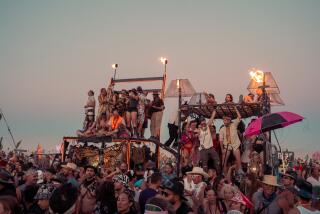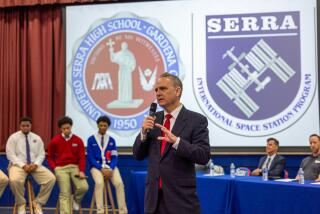As a family vacation, Space Camp is out there
Huntsville, Alabama
“Ten, nine, eight, seven, six, five!” the kids yelled.
It wasn’t as deafening as Times Square on New Year’s Eve, but the 300 or so children attending Space Camp were as enthusiastic as any midnight revelers. The space shuttle Atlantis was poised to blast off, and by luck, its Friday night launch coincided with the start of our trip to Alabama to learn about astronauts.
The campers — some as young as 7, many in their teens — continued the countdown, a crescendo of “four, three, two, one!”
They applauded as Atlantis cleared the tower and thundered into the Florida sky, watching raptly as the orbiter’s crew jettisoned its solid rocket boosters (or SRBs, as we soon would learn to call them) and activated its main engine cutoff (“We have MECO!” shouted one older kid particularly well versed in NASA-speak).
During our 2 1/2 Space Camp days, my son, Charles, and I would learn (and repeatedly fail to remember) all manner of NASA acronyms, clamber into various low-gravity rides and simulators, study rocketry history and even wobble around in a pretend — and comically catastrophic — space walk.
Watching the Atlantis launch with our fellow campers crystallized the risks, rewards and technical challenges of the very thing we were studying.
As soon as Charles and I finished watching the blastoff, we gathered with our small group to climb into a space shuttle simulator and practice for our own mission.
Space Camp, now celebrating its 25th year, is part hands-on field trip, part pack-a-washcloth sleepover camp. It’s an outgrowth of the U.S. Space & Rocket Center’s museum education program and one of the center’s many camp programs aimed at science-minded kids, some of whom bring parents, some of whom don’t.
We had signed up for a parent-child program, a course from Friday afternoon to Sunday morning that’s geared for kids 7 to 12.
Most of the other Huntsville campers were at the camp alone, either attending parentless Space Camp (ages 9 to 11), Space Academy (12 to 14) or Advanced Space Academy (15 to 18). The center offers identical programs oriented around aviation and fighter pilot training.
Because there are no nonstop flights from Los Angeles to Huntsville, Charles and I routed ourselves through Washington, D.C., for some pre-camp cramming. On our layover day, we visited both of the Smithsonian’s National Air and Space museums — the familiar one on the Mall and the newer, more expansive (and far less crowded) Steven F. Udvar-Hazy Center, near Washington Dulles International Airport.
By the time we were ready to leave Washington for Huntsville, we had seen the Apollo 11 command module Columbia, the Gemini VII capsule and the Space Shuttle Enterprise.
The perils of space flight were fresh in our minds too: We visited memorials at Arlington National Cemetery for the 14 crew members killed in the destruction of shuttles Challenger (1986) and Columbia (2003).
After a two-hour Thursday night flight from Washington to Huntsville in northern Alabama, we caught a free hotel shuttle to the Huntsville Marriott, just a few yards from Space Camp. Registration didn’t start until Friday morning, so we spent the night at the hotel. (The camp also offers roundtrip shuttle service from the airport for $25.)
Space Camp is conducted in and around the rocket center’s campus, which includes a bustling museum with the Apollo 16 capsule and a Mars-themed climbing wall, a variety of space-related theme-park rides, an Imax theater showing space movies, a rocket park filled with various NASA artifacts, including a Saturn V rocket, and a full-scale Space Shuttle prototype — sitting atop a massive external tank (or BOT, for big orange thing) and two SRBs (solid rocket boosters, remember?).
With scores of campers arriving and departing simultaneously and no clearly marked registration table, checking into Space Camp was chaotic. This took place in Habitat, which, for better or worse, was also where we slept. It was a hybrid of a futuristic astronaut dormitory/space station and (to more than a few parents, including me) felt a little bit too much like an upscale correctional facility. Each of its floors held six-person bedrooms; bathrooms were communal but separated by gender.
Because we’d arrived a bit early and our rooms weren’t ready (even though you make your own beds), Charles and I toured the somewhat overly militaristic museum, with a prominent exhibit called “Team Redstone: Supporting the Army Transformation,” and a surprising number of weapons and military equipment on display.
We grabbed a quick lunch at the Galaxy Food Court, serving museum-quality salads, chicken strips and burgers. Charles kept noticing that about a quarter of the campers were wearing blue flight suits. Although the suit was not required for camp and I had purposefully not ordered one with our camp registration, it clearly was important to Charles, so I bought him one for $80. The uniform shop clerk quickly stamped out a fancy name tag for Charles and told him he had to wear it upside down until he graduated.
We then headed back to Habitat, where we picked up our 10-thread-count sheets, blankets and pillows, lugged our suitcases up to our second-floor quarters, and made our beds. We were told to report to the lobby to meet the other members of our group and our advisor, Bob Jones.
The parent-child campers were divided into four teams of eight kids. Our band was called Apollo; other groups were dubbed Gemini, Mercury and Shuttle.
Apollo was an interesting, friendly bunch: There was one girl among seven boys, and the array of dads was diverse — one a poet, another a hedge fund manager, another an elementary school teacher. We hit it off instantly.
Because so many campers, including (but hardly limited to) the parent-child crowd, were competing for time in a limited number of apparatuses, we were handed in our first meeting a spreadsheet on which the next 2 1/2 days were broken into half-hour increments. It looked like a lot to accomplish. “It is possible to learn and have fun at the same time,” we were told by the camp’s Matthew Green during our orientation.
Charles and I were determined to prove him right.
Space travel 101
Our weekend began with an hourlong overview of how the shuttle is assembled and how it flies and concluded with a competitive trivia quiz focused on space history, those dreaded acronyms and even some subjects we hadn’t studied: Charles was asked the French word for a rocket docking (rendezvous).The history lessons may have glossed over Werner von Braun’s little Nazi problem and failed to mention that the Russian dog Laika, the first animal in space, died mere hours after launch, but we also learned plenty of fun space stuff. Charles’ favorite: Half of all astronauts get space sick, and sometimes their, um, output eludes the air sickness bags and floats around in zero gravity.
Most of the educational opportunities paled compared to riding in the Space Camp toys — which is really why we came to Huntsville.
The first day, we strapped ourselves into the 1/6th Chair, which is supposed to simulate the moon’s gravity. One at a time, parent and child were secured into a rig connected to a series of springs; with a good push, you could fly higher than Kobe Bryant.
After a hurried dinner of typical camp food and watching the Atlantis launch, we dashed to the Endeavour, a partial mock-up of a shuttle orbiter.
The Endeavour training and mission stand at the curriculum’s center. During the weekend, we had two training missions and two “flights” inside the relatively realistic orbiter, filled with all sorts of computer screens, buttons and switches. The eight pairs of parents and children were assigned jobs alongside one another.
In our first mission, Charles and I were assigned to be “mission specialists,” meaning we got to go on a space walk. Before we could have our EVA (extravehicular activity), though, we had to get the Endeavour into space.
One parent-child team was commander and pilot of the orbiter, another pair served as flight director and capsule communications officer in mission control, and so on. Almost everybody wore a microphone headset and followed a countdown and launch script with their lines highlighted.
It was like the spacecraft I had created with cardboard boxes, blankets and duct tape when I was a kid — but far cooler.
“I am switching on all three fuel cells and main power supplies,” Charles said, flipping a battery of switches. “We are go for SSME gimbal check,” one of the dads said over his microphone, referring to the space shuttle main engines. “Ignition systems armed!”
Simple? Not quite
After we theoretically launched, Charles and I donned our spacewalk suits (complete with air-cooled helmets) and were secured into a rig that approximated weightlessness. Our task sounded simple: Thread some steel rods into some fasteners and build a little metal structure. But with the helmets, the gloves and the weightless rig, it was hot, painstaking work.The practice run seemed to have gone well enough, but when show time came, we didn’t get the structure assembled in time. (We had no idea the clock was running.) Our fellow space campers closed the payload doors and reentered the atmosphere without us.
“Well, at least we’ll get buried at Arlington,” I told Charles.
“If they ever find us!” he replied.
Our second mission went better. Charles and I were assigned the roles of station commander and station scientist, which consisted mostly of making super balls and homemade slime.
When we weren’t dying in space or mixing up chemicals, Charles and I and the rest of the Apollo team went to see a couple of Imax movies, built and flew model rockets, designed a mission patch and a Lego space station, studied more space history and had a chance to ride several other simulators.
I wisely opted out of MAT, or multi-axis trainer, connected giant rings that flip and spin the rider like a human frappuccino. When Charles staggered out of it, his face was gray, his stomach in another galaxy.
By graduation time Sunday morning, Charles was feeling much better, and when we turned his space suit’s name tag around, he beamed like an astronaut returned to Earth. He wore the suit the entire flight home.
john.horn@latimes.com
More to Read
Only good movies
Get the Indie Focus newsletter, Mark Olsen's weekly guide to the world of cinema.
You may occasionally receive promotional content from the Los Angeles Times.











